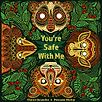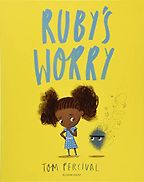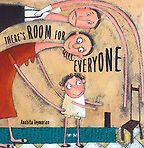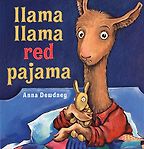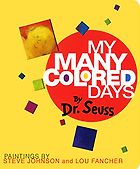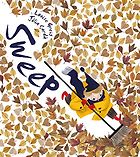How can books be used to help a child overcome anxiety and worries?
I think a book is a tool that can be used to frame the problem of anxiety with an outside entity: another child or another animal is having the same anxieties you’re having, and you can then explain that this animal is no longer scared for these reasons.
My book, You’re Safe With Me, is about thunderstorms. I was trying to explain thunderstorms in a very poetic way, as a storyteller would. I thought by doing that, children would break down the thunderstorm into things that are more beautiful and not fear it as much. That’s where it started. Most of the time when I read it to them, children start out with, ‘I’m scared of thunderstorms.’ Then as we go through and break it down, we say, ‘Oh we’re not scared of white clouds. We’re not scared of rain.’ Finally, they say, ‘I’m not scared of thunderstorms anymore, because I’ve seen what goes inside a thunderstorm and I can see what happens after a thunderstorm.’
We’ve also used You’re Safe With Me as part of empathy lab to do an empathy session. The children were able to look at their anxiety from a different perspective. Rain is scary only when you think of it as rain. When you think of it as watering the forest, it doesn’t feel scary anymore. It’s just doing a job. In the lab, children were able to integrate all that by being lead a bit and asked the right questions. That works with all the books that have some kind of anxiety as their theme.
Many children have gone through slightly anxious periods and I’ve found that only when they’re cuddled up in bed and safe do they feel they can let their guard down and process what they’re feeling. They don’t even need to say much; they can just go through those feelings with the characters in the book.
The child will always try to put itself in the shoes of the main character. They don’t want to talk about their fears because they don’t want to say, ‘I’m scared of monsters,’ or ‘I’m scared of darkness.’ But when you say, ‘This character’s scared of darkness’ then they’re willing to say, ‘Okay, actually, me too a little bit.’ You can then use that to bring out their fears and help them talk about it. Because of their age and their experience, they don’t know that other people are going through the same things. When they discover that, they feel a little less lonely and that it’s okay to tell their mum or teacher about it. That’s how books can be used. And sometimes, you don’t even have to bring out anything. You just have to read the book and then they process it over a couple of days and then they come back and talk about it.
Let’s go through some of the other books that could help young children overcome anxieties that you’re recommending. Which one shall we start with?
One of my absolute favourites is Ruby’s Worry. I read the first one in the series with my nephews. It goes back to what I said about externalizing another child’s worry so that you can talk about the worry as well. Also, this idea that the more the child keeps it inside, the bigger it gets. That’s easy for children to understand—that they can talk about it, because otherwise it’s going to get bigger. They can then ask questions about their worry, they can talk about it, and the worry disappears. The book gives them the tools to understand what happens when you don’t talk about it. It also gives you the tools the understand how to get rid of it. Tom Percival is amazing. In a simple way, he’s made it so accessible for parents to be able to talk about children’s worries and anxieties.
Not every parent is a psychologist. Even more for parents than for children, books are an accessible way to deal with a child’s anxiety, because you can literally find a book that deals with what your child is going through and use it to talk through it with your child.
For readers who aren’t familiar with Ruby’s Worry, what’s the basic premise?
Ruby does a lot of things and then she has a little worry. She keeps it to herself and then it keeps getting bigger and bigger and bigger until she has to deal with the anxiety. That is how children deal with worry, because they don’t want to talk about it. They’re not sure it’s something that their parents are interested in, or sometimes, they’re not sure how to talk about it. This book helps them to voice what they’re going through.
The second book on your list is My Many Coloured Days by Dr Seuss.
This book gives parents and kids tools and language to explain worries. If you’ve gone through the book and your child doesn’t talk about their anxieties and worries right away, they might come back another day and could say, ‘I’m having a blue day’ or ‘I’m having a yellow day.’ You suddenly realize they’ve been listening when you’re reading that book. It’s a fantastic way to help them.
“Dr Seuss has taken the literal way we say we’re having a blue day and converted that into a beautiful book”
They could show you by colouring or you can have code words within the family like saying, ‘Are you feeling a little bit blue today?’ and they’ll know what that means. Dr Seuss has taken the literal way we say we’re having a blue day and converted that into a beautiful book explaining how worry works. Also, as always in Dr. Seuss books, it’s a lot of fun to read.
It’s a simple image, isn’t it? Sometimes when children hear words like anxiety and fear, they sound like rather complex and scary.
Yes, and when you come back to it they can either reference the colour or they could reference the characters. So they could be having a bright blue day. They could be having a green day. They could be having a purple day. That means they’re sad and they want to walk alone. There are also black days, which means they’re angry. Best of all, they could have a mixed up day.
For children, the rhyme works great and they love it. They can actually start using it, playing with it. My nephews love making up their own rhymes. It helps them to be able to say things like this on their own as well.
Your third choice is There’s Room For Everyone by Anahita Teymorian.
I wanted to include this book, even though it is not necessarily about mainstream anxiety. Not every child is going to be a refugee, but there are many children today in our societies who have come from that background. Also, I think it does apply to other children who have moved schools, or who just feel a bit different to the others.
“The message of the book is that there is room for everyone”
The message of the book is that there is room for everyone. There is enough room for all the fishes in the sea and those fishes can be different. There is enough space for all the stars in the sky and they can be different. Children don’t have to feel bad about finding a place of their own, whether it’s in a new classroom or in a new family or in a new society. Even though the book feels like it’s telling the story of a refugee child, it’s also telling the story of any child who finds themselves in a new environment. When children go from year one to year two, or they’re going from nursery to reception, they feel like suddenly they’ve got different friends and different chemistries within the school and within the playground. Or they have a new friend circle and new birthday party and they don’t feel like they know everybody. They can still find their own space within that environment.
For readers who aren’t familiar with it, could you briefly explain the story?
The book goes through how a child discovers various things in nature and that there’s enough space in the sky for birds and enough space in the ocean for whales. It then asks why people fight for space. Why can’t they be a little bit kinder to each other? For me, it was very useful to then correlate that to a playground environment. A child comes to me and says, ‘I wanted to use the seesaw but somebody else is on it.’ And you suggest that they can go and ask in a nice way and maybe the other child will let you have a go. But if you fight for it, then probably neither of you are going to enjoy what’s going to happen.
At the same time, it’s actually a story about how we think we don’t have space for somebody coming from another place. Especially in this Brexit climate and with the situation in the US, I think it’s perfect to read this book at this time.
Get the weekly Five Books newsletter
Not all parents are liberal. There are parents who need to read this story to understand that we don’t have to be scared of the new neighbours or new children at school. Whether they’re eastern European or refugees, you don’t have to worry about them.
Some adults can understand these concepts by reading children’s books. This is something we did on Twitter recently and a lot of people have picked up on it. Children’s books have all of these concepts which are not in adult books because usually adults are in an echo chamber. They only read books they like to read. So if I support Brexit, I read more of the negative things about immigration. But if I read a book like this, then I think, ‘Actually, I’m going to question my understanding of what Brexit is and whether I’m feeling the wrong kind of fear.’
Your fourth choice is Llama Llama Red Pajama by Anna Dewdney.
I first read this a long time ago and I didn’t necessarily think of it as an anxiety book but after looking at anxiety books since You’re Safe With Me came out, I realised it was about the ‘Mum hasn’t come home’ worry. The phenomenon of parents working or doing shift work or one parent having to go away or to travel for work is so common. Especially if the mum is working, this book is a great way to talk to the child about this type of anxiety.
In this book the mum is late for bedtime and the child is left anxiously waiting. There is a YouTube reading of this book by the author. When his mum leaves the room he gets more and more anxious and then really upset. Especially in India, we don’t put children in separate rooms until they’re much older. Obviously, some of it is to do with space and some of it’s to do with lack of privacy as a cultural thing. But here, you do leave young children in a room by themselves. That can be overwhelming for some children. In this story, he starts with a small whimper and then he goes to a total tantrum. Then, he has to learn to deal with it.
It’s a book which lots of parents relate to because they have dealt with how they’re going to manage bedtime with their child.
Your final choice is another excellent book: Sweep by Louise Greig.
Sweep is very similar to Ruby’s Worry. It starts with a small worry that becomes bigger and bigger and bigger. In Ruby’s Worry, you have this cloud over her head or sitting on her shoulder. Sweep is in an autumn book with the anxiety visualized by the illustrator, Julia Sarda, as leaves. As the worry gets bigger and bigger and bigger, you get big emotions and a huge pile of leaves that you can’t deal with anymore. The book was nominated for the Kate Greenway Medal, as well as being shortlisted for the Klaus Flugge and the Waterstones Prize.
I think a lot of parents are now talking to children about anxiety and worries. Some people now say the millennials are the most anxious generation of all. A lot of it has to do with social media, and all the anxieties coming from peer pressure and dealing with bullies online. These things don’t go away because they invade your home now through your phone. So there are a lot more books now dealing with anxiety.
You’re a storyteller and you draw on your childhood in India and Indian myths and epics to write your books. Could you tell me how that impacts your writing?
Yes, as a storyteller, I get more out of the telling of the story than from the writing. I don’t ever read books (even my own) when I perform: I always tell the story. Because it always changes based on who your audience is and I realised that I can break it down in a different way.
Five Books interviews are expensive to produce. If you're enjoying this interview, please support us by donating a small amount.
Even though You’re Safe with Me is an original story, I wanted it to have a folktale feel. I wanted to have a storyteller or a mother figure in the story who was necessarily not the mum of these animals, but a matronly figure who could help with the handling of the anxiety or the fear. That is how we grew up. We had my grandmother and my grandmother’s sister and lots of different people in the house. We were a joint family. I wanted that feeling to come through in the book, as if it’s different children from different backgrounds all in the same story. The four animals are Indian animals but they’re not necessarily animals that would live together. But they are listening to this story together and questioning it together. It works really well in a classroom because teachers realise it brings together children from different areas, and backgrounds. They’re all having different types of anxieties or fears and this one person can bring them all together.
It’s melodic and beautiful but there’s an underlying ecological point being made. It bridges an awful lot of ideas and themes for such a slim book.
That’s probably the strength of a picture book, that it can go into those layers and children discover them. For example, if I tell the story in a school setting, I always point out that it talks about the water cycle because you get rains and the water goes to the river. The river goes to the ocean and then comes back as rain.
Five Books aims to keep its book recommendations and interviews up to date. If you are the interviewee and would like to update your choice of books (or even just what you say about them) please email us at [email protected]

